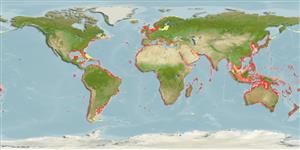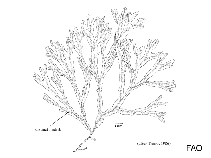Dictyota dichotoma (Hudson) J.V. Lamouroux
Forked ribbons| Native range | All suitable habitat | Point map | Year 2050 |

|
| This map was computer-generated and has not yet been reviewed. |
| Dictyota dichotoma AquaMaps Data sources: GBIF OBIS |
Upload your photos
Google image | No image available for this species;
drawing shows typical species in Dictyotaceae.
Google image | No image available for this species;
drawing shows typical species in Dictyotaceae.
Classification / Names Common names | Synonyms | CoL | ITIS | WoRMS
Phaeophyceae | Dictyotales | Dictyotaceae
Environment: milieu / climate zone / depth range / distribution range Ecology
Epiphytic; depth range 0 - 55 m (Ref. 80758). Subtropical
Distribution Countries | FAO areas | Ecosystems | Occurrences | Introductions
Indo-Pacific, Atlantic Ocean and the Mediterranean.
Length at first maturity / Size / Weight / Age
Maturity: Lm ? range ? - ? cm
Short description Morphology
Thalli erect, light to dark brown, attached to the substrate by a small discoid holdfast. Branching regularly dichotomous, forming angles of 15° to 35°. Branches strap-shaped, 3 to 6
mm wide, broadest below each fork. Apices of terminal segments emarginate. Blade margin entire with occasional short stubby spines. Cross-section of a branch shows 3 layers of cells, consisting of a middle layer of large, rectangular cells, and bounded on the upper and lower surfaces by a layer of small, cuboidal and pigmented cortical cells. Thalli up to 14 cm in height (Ref. 80758).
A good source of alginate, an emulsifying, stabilizing and gelling agent in several food products such as frozen food, pastries, jellies, salad dressings, ice cream, meat and flavor sauces, beer, fruit juices, and milk shakes (Ref. 80758). Grows abundantly in shallow waters throughout the year; also found on rocks below the low tide mark at calm open coasts and sheltered coasts though some have been reported from a depth of 55 m (Ref. 80758).
Life cycle and mating behavior Maturity | Reproduction | Spawning | Eggs | Fecundity | Larvae
Main reference
References | Coordinator | Collaborators
Guiry, M.D. and G.M. Guiry. 2009. (Ref. 80701)
IUCN Red List Status (Ref. 130435)
CITES status (Ref. 108899)
Not Evaluated
CMS (Ref. 116361)
Not Evaluated
Threat to humans
Harmless (Ref. 80758)
Human uses
| FishSource |
Tools
More information
Internet sources
BHL | BOLD Systems | CISTI | DiscoverLife | FAO(Publication : search) | Fishipedia | GenBank (genome, nucleotide) | GloBI | Gomexsi | Google Books | Google Scholar | Google | PubMed | AlgaeBase | Tree of Life | Wikipedia (Go, Search) | Zoological Record
Estimates based on models
Preferred temperature
(Ref. 115969): 12.6 - 29, mean 26.7 (based on 3268 cells).



